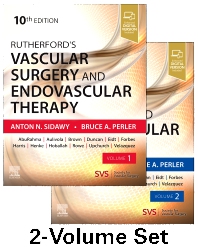ラザフォード 血管外科・血管内治療(第10版・全2巻)
Rutherford’s Vascular Surgery and Endovascular Therapy 10th edition With EXPERT CONSULT Online Access

By Anton N Sidawy, MD, MPH, Professor of Surgery, The George Washington University Hospital, Washington DC and Bruce A Perler, MD, MBA, Professor of Surgery, The Johns Hopkins Hospital, Baltimore, Maryland
2022:07 2 vols. 2,928 p. 1,734 illus. ISBN 978-0-323-77557-1 (Elsevier) –US-
USD 446.99
Web販売価格:税込¥75,670 / 標準価格:税込¥101,286
*2024年7月17日時点の価格です。実際の価格は、為替レートや出版社の都合により変動いたしますので、最新の価格は以下オンラインストアリンクをご参照ください。
*Web販売価格は、紀伊國屋書店BookWeb Proでご注文され、付帯作業を伴わない納品を行い、弊社標準書式による請求書を発行し遅滞なくお支払いただく場合、あるいは、クレジットカードでお支払いいただく場合に適用される販売価格です。
概要
アメリカ血管外科学会(the Society for Vascular Surgery)の後援の、権威ある成書ラザフォードの4年ぶりの改訂第10版です。診断技術や血管生物学の基礎から画像診断、非侵襲的療法までを網羅します。
今版では、新たなセクションで、テクノロジー・プラットフォームとソーシャルメディアの使用を、新たな章で、遠隔医療、外来透析センターと専門横断型心臓血管センターの運営、オンライン血管情報開示などを取り上げます。さらに、新たなコンテンツとして、複雑な大動脈疾患の血管内治療、小児患者の急性血管閉塞、外来患者の血管ケア、開腹手術のための解剖外科を含みます。
付属のオンライン版Expert Consult(個人利用のみ可能)では、本文閲覧、検索、最新手技の動画閲覧などが可能です。循環器科・外科、医学図書館に必携の参考図書としてお薦めいたします。
価格照会・ご購入
※本件についてのお問い合わせ、お見積りについては最寄りの紀伊國屋書店営業所もしくはこちらまでお願いいたします。
内容明細
Chapter 1. Epidemiology and Research Methodology
Clinical Research Methods
What’s Next For Vascular Surgeons In Outcomes Research
Chapter 2. Embryology and Developmental Anatomy
Formation of Embryonic Blood Vessels
Development of The Descending (Thoracic And Abdominal) Aorta
Development of The Venous System
Development of The Lymphatic System
Chapter 3. Vessel Wall Biology
Structure of The Vessel Wall
Molecular Identity of Arteries, Veins, Lymphatics
Hemodynamics And Vascular Wall Biology
Chapter 4. Atherosclerosis
Atherosclerosis As A Chronic Inflammatory Disease
Localization of Atherosclerosis
Progression/Regression of Plaques
Thrombotic Complications of Atherosclerosis
Identification of Vulnerable Lesions
Chapter 5. Intimal Hyperplasia
Biology of Intimal Hyperplasia
Clinical Factors In The Development of Intimal Hyperplasia
Clinical Scenarios of Intimal Hyperplasia
Chapter 6. Ischemia-Reperfusion
Impact of Ischemia-Reperfusion Injury on The Vasculature
Vascular Ischemia-Reperfusion Injury Scenarios And Clinical Trials
Pathophysiology of Ischemia-Reperfusion Injury
Chapter 7. Arteriogenesis and Angiogenesis
Role of Noncoding Rnas in Neovascularization
Chapter 8. Arterial Hemodynamics
Introduction: The Physics of Arterial Flow
Understanding Pulsatile Pressure And Flow Waves In The Arterial System
Short-Term Regulations of Hemodynamics
Long-Term Regulations of Hemodynamics
Image-Based Computational Analysis of Arterial Hemodynamics
Chapter 9. Venous Pathophysiology
Chronic Venous Insufficiency
Chapter 10. Lymphatic Pathophysiology
Section 2. Atherosclerotic Risk Factors
Biologic Effects of Smoking on the Vasculature
Nonvascular Clinical Effects
Vascular Clinical Effects
Classification of Diabetes
Diabetes and Vascular Disease
Pathophysiology of Vascular Disease in Diabetes
Vascular Evaluation of Patients With Diabetes
Treatment of Patients With Diabetes and Peripheral Artery Disease
Summary and Future Directions
Chapter 13. Hyperlipidemia
Physiology and Metabolism of Lipids
Pathophysiology of Atherosclerosis
Diagnosis of Atherogenic Lipid Disorders
Evolution of the Guidelines for Management and Therapeutic Goals for Lipoprotein Disorders
Clinical Trials of the Management of Dyslipidemia in Peripheral Arterial Disease
Nonpharmacologic Therapy for Dyslipidemia
Pharmacologic Therapy for Dyslipidemia
Hypertension and Atherosclerosis
Chapter 15. Familial Arteriosclerosis
Familial Hypercholesterolemia
Genetics of Peripheral Artery Disease
Influence of Nongenetic Factors
Risk Assessment and Diagnosis
Chapter 16. Less Commonly Considered Causes of Atherosclerosis
The Atherosclerotic Lesion
Chapter 17. International and Ethnic Trends in Vascular Disease
Section 3. Clinical and Vascular Laboratory Evaluation
Chapter 18. Noninvasive Vascular Laboratory Quality Assurance and Accreditation
Development of Quality Programs in Manufacturing
Components of Quality Programs
Fundamentals of Total Quality Management
Quantitative Imaging Biomarkers
Prospects for Improved Models of Accreditation
Chapter 19. Clinical Evaluation of the Arterial System
Overview of the Clinical Evaluation
History in Patients With Arterial Disease
Physical Examination in Patients With Arterial Disease
Chapter 20. Clinical Evaluation of the Venous and Lymphatic Systems
Chapter 21. Vascular Laboratory: Arterial Physiologic Assessment
Chapter 22. Vascular Laboratory: Arterial Duplex Scanning
Instrumentation and Basic Concepts
Chapter 23. Techniques to Assess Tissue Perfusion in Peripheral Arterial Occlusive Disease
Invasive Techniques to Assess Tissue Perfusion
Noninvasive Techniques to Assess Tissue Perfusion
Chapter 24. Vascular Laboratory: Venous Physiologic Assessment
Ambulatory Venous Pressure
Reliability of Venous Testing
Chapter 25. Vascular Laboratory: Venous Duplex Scanning
Normal B-Mode Imaging Findings
Normal Flow Patterns in Veins
Diagnosis of Deep Venous Thrombosis
Iliac Veins and Inferior Vena Cava
Diagnosis of Upper Extremity Deep Venous Thrombosis
Limited or Point-of-Care Ultrasound Examinations
Determination of Thrombus Age
Novel Ultrasound Techniques: Elastography
Determining the Duration of Therapy for Acute DVT
Diagnosis of Recurrent Thrombosis
Evaluation for Chronic Venous Disease: Venous Insufficiency
Section 4. Vascular Imaging
Chapter 26. Radiation Safety
Biologic Effects of Radiation
Exposure And Recommended Limits
Principles of Radiation Protection
Radiation Safety: Diagnostic Procedures
Radiation Safety: Endovascular Procedures
Radiation and the Endovascular Surgeon
Chapter 27. Arteriography
Venography for Specific Regions And Conditions
General Limitations and Risks of Venography
Chapter 29. Computed Tomography
Special Pediatric Considerations
Chapter 30. Magnetic Resonance Imaging and Arteriography
Clinical Applications of Mr Angiograpy
Chapter 31. Vascular PET/CT and SPECT/CT
Chapter 32. Intravascular Ultrasound
Chapter 33. The Future of Imaging for Endovascular and Open Surgery
X-Ray Imaging and Hybrid Operating Rooms
Advanced 3D Imaging and Image Guidance Techniques
Endovascular Navigation and Catheter Robotics
The Future of Hybrid Operating Suites
Section 5. Perioperative Care
Chapter 34. Preoperative Evaluation and Management
General Preoperative Risk Assessment
Chapter 35. Intraoperative Management
Intraoperative Monitoring
Maintenance of Homeostasis
Anticoagulation And Antiplatelet Therapy
Control of Blood Loss and Transfusion
Venous Thromboembolic Prophylaxis
Special Intraoperative Techniques
Chapter 36. Postoperative Management
Admission To The Intensive Care Unit And High-Dependency Step-Down Unit
Hemodynamic And Pressure Monitoring
Cardiovascular Management
Fluid And Electrolyte Management
Chapter 37. Hospital Readmissions in Vascular Surgery
Hospital Readmissions Reduction Program
Readmissions In Vascular Patients
Interventions To Decrease Readmissions In Vascular Surgery
Limitations of 30-Day Readmissions
Existing Interventions To Reduce 30-Day Post-Procedure Readmissions And Alternative Metrics
Section 6. Bleeding and Clotting
Chapter 38. Normal Coagulation
Procoagulant, Anticoagulant, Fibrinolytic Proteins, Inhibitors, And Receptors
Connectivity And Dynamics of Blood Coagulation
Blood Coagulation Monitoring
Future Coagulation Assays
Chapter 39. Disorders of Coagulation: Hemorrhage
Diagnosis and Preoperative Screening for Bleeding Disorders
Chapter 40. Disorders of Coagulation: Hypercoagulable States
Congenital Hypercoagulability
Acquired Causes of Hypercoagulability
Evaluation And Workup of Hypercoagulable States
Choice And Duration Of Anticoagulation Therapy
Chapter 41. Anticoagulant Therapy
Parenteral Anticoagulants
Parenteral Direct Thrombin Inhibitors
Perioperative Management of Anticoagulant Agents
Chapter 42. Antiplatelet Agents
Normal Platelet Function and Platelet Activation
Thienopyridines (Adenosine Diphosphate Receptor Antagonists)
Glycoprotein IIB/IIIA (GPIIB/IIIA) Inhibitors
Phosphodiesterase Inhibitors
Protease-Activated Receptor-1 Inhibitors
Clinical Use of Antiplatelet Agents in Vascular Disease
Perioperative Management of Dual Antiplatelet Therapy
Chapter 43. Thrombolytic Agents
Thrombolytic Drug AdministrAtion
Chapter 44. Systemic Complications: Cardiac
Pathophysiology of Major Adverse Cardiac Events
Definition and Optimization of Cardiac Risk Prior to Surgery
Preoperative Evaluation for Coronary Artery Disease
Preoperative Coronary Angiography and Revascularization
Best Medical Therapy to Reduce Perioperative Cardiac Complications
Intraoperative Variables Impacting Mace
Postoperative Management of Cardiac Complications
Chapter 45. Systemic Complications: Respiratory
Preoperative Risk Stratification
Perioperative Risk Reduction
Chapter 46. Systemic Complications: Renal
Renal Dysfunction After Vascular and Endovascular Procedures
Ischemic Injury to the Kidney
Altered Renal Function During Aortic Surgery
Medical Management of Acute Renal Failure
Chapter 47. Systemic Complications: Neurologic
Other Causes of Nerve Injury
General Principles of Treatment
Chapter 48. Graft Thrombosis
Intraoperative Graft Assessment
Graft Thrombosis: Pathogenesis
Graft Thrombosis: Therapeutic Approach
Chapter 49. Graft Infection
Surgical Treatment And Outcomes
Chapter 50. Anastomotic Aneurysms
Incidence and Anatomic Location
History and Physical Examination
Chapter 51. Local Complications: Aortoenteric Fistula
Primary Aortoenteric Fistula
Secondary Aortoenteric Fistula
Aortoenteric Fistula After Endovascular Repair
Chapter 52. Local Endovascular Complications and their Management
Access Site Complications
Upper Extremity Access Complications
Percutaneous Closure Device Complications
Procedure-Specific Complications
Other Endovascular Procedure Complications
Chapter 53. Venous Complications
Incidence of Venous Complications
Complications from Venous Endovascular Interventions
Inferior Vena Cava Filter Complications
Chapter 54. Local Complications: Lymphatic
Retroperitoneal Lymphocele
Chapter 55. Thoracic and Thoracoabdominal Vascular Exposure
Exposure Of The Ascending Aorta And Aortic Arch
Exposure Of The Distal Aortic Arch And Descending Thoracic Aorta
Exposure Of The Descending Thoracic Aorta And Paravisceral Aorta
Exposure Of The Abdominal Aorta
Chapter 56. Abdominal Vascular Exposures
Exposure of Major Abdominal Arteries
Exposure of the Abdominal Veins
Chapter 57. Cerebrovascular Exposure
Exposure of the Extracranial Carotid Artery for Carotid Endarterectomy
Reoperative Exposure for Carotid Stenosis
Exposure for Subclavian–Carotid Interventions
Vertebral Artery Exposure
Posterior Exposure of the Suboccipital Vertebral Artery (V4) Segment
Chapter 58. Lower Extremity Arterial Exposure
Popliteal Artery Exposure
Exposure of the Tibial and Peroneal Arteries
Exposure of the Arteries of the Foot
Exposure for Obturator Bypass
Exposure of the Lower Extremity Veins
Chapter 59. Upper Extremity Vascular Exposure
Exposure of Arteries Within the Thorax
Exposure of Veins Within The Thorax
Exposure of Vessels Within the Thoracic Outlet
Exposure of The Arm Vessels
Chapter 60. Spinal Operative Exposure
Clinical Presentation, Diagnostic Evaluation, and Risk Assessment
Surgical Results and Complications
Postoperative Management and Follow-Up
Chapter 61. Open Surgical Technique
Basic Vascular Techniques
Thrombectomy and Thromboembolectomy
Transected or End-to-End Vessel Reconstruction
Replacement and Bypass Procedures
Adjunctive Techniques for Infraingiunal Bypass Anastomosis
Chapter 62. Endovascular Diagnostic Technique
Technique for Catheterization
Chapter 63. Endovascular Therapeutic Technique
Devices for Crossing Chronic Total Occlusions
Endovascular Therapeutic Techniques
Chapter 64. Laparoscopic and Robotic Aortic Surgery
Total Laparoscopic Aortic Surgery
Hand-Assisted Laparoscopic Aortic Surgery
Totally Robotic Aortic And Robot-Assisted Procedures
Section 9. Grafts and Devices
Chapter 65. Autogenous Grafts (Including Vein Harvest, Surgical and Endoscopic)
Preoperative Vein Mapping
Endoscopic and Minimally Invasive Vein Harvest
Autogenous Graft Configurations
Other Autogenous Conduits
Chapter 66. Prosthetic Grafts
Chapter 67. Biologic Grafts
Clinical Use In Vascular Surgery
Chapter 68. Bioengineered Vascular Grafts
Chapter 69. Nonaortic Stents and Stent Grafts
Stent Types and Characteristics
Chapter 70. Novel and Evolving Aortic Endovascular Devices
Aortic Arch and Thoracic Aorta
Section 10. Abdominal Aortic and Iliac Aneurysms
Chapter 71. Arterial Aneurysms: Etiology, Epidemiology, and Natural History
Current Aneurysm Management
Chapter 72. Aortoiliac Aneurysms: Evaluation, Decision Making, and Medical Management
Screening and Surveillance Recommendations
Indications for Intervention
Chapter 73. Abdominal Aortic Aneurysms: Open Surgical Treatment
Evolving Roles of Oar and Evar
Impact of Oar Volumes on Outcomes and Training
Current Indications for Open Aortic Repair
Preoperative Assessment and Planning
Anatomic Considerations in Abdominal Aortic Surgery
Intraoperative Principles in Abdominal Aortic Surgery
Postoperative Complications
Special Surgical Considerations and Variations
Infected Abdominal Aortic Aneurysms
Inflammatory Abdominal Aortic Aneurysms
Chapter 74. Endovascular Aneurysm Repair Techniques
Deployment Precision and Ease of Use
Graft Slection and Primary Device Characteristics
Anesthesia, Access, and Imaging
Chapter 75. Aortoiliac Aneurysms: Endovascular Treatment
Randomized Trials of Endovascular Aneurysm Repair Versus Open Repair
Endovascular Aneurysm Repair Compared with Medical Management
Endovascular Aneurysm Repair in Ruptured Abdominal Aortic Aneurysms
Complications of Endovascular Aneurysms Repair
Endovascular Repair of the Juxtarenal Aorta
Endovascular Repair of Common Iliac and Internal Iliac Artery Aneurysms
Cost of Endovascular Aneurysm Repair
Chapter 76. Ruptured Aortoiliac Aneurysms and their Management
Pathophysiology of Aortic Rupture
Initial Management Strategies
Operative Strategies: Endovascular Repair
Operative Strategies: Open Repair
Complications of Ruptured Abdominal Aortic Aneurysm Repair
Outcomes of Ruptured Abdominal Aortic Aneurysm Repair
Chapter 77. Isolated Iliac Artery Aneurysms and their Management
Section 11. Thoracic and Thoracoabdominal Aortic Aneurysms and Dissections
Chapter 78. Thoracic and Thoracoabdominal Aortic Aneurysms: Etiology, Epidemiology, Natural History, Medical Management, and Decision Making
Thoracic Aorta: Anatomy And Epidemiology Of Thoracic Aortic Aneurysms And Thoracoabdominal Aortic Aneurysms
Other Pathologic Diseases of the Thoracic Aorta
Chapter 79. Thoracic and Thoracoabdominal Aneurysms: Open Surgical Treatment
Indications for Surgical Treatment
Impact of Endovascular Treatment
Effect of Surgical Technique On Morbidity
Long-Term Survival and Quality of Life
Chapter 80. Thoracic Aortic Aneurysms: Endovascular Treatment
Approved Devices For Thoracic Endovascular Aortic Repair
Chapter 81. Aortic Stent Graft and Endovascular Treatment of Thoracoabdominal and Aortic Arch Aneurysms: Strategies for Operative Repair
Strategies for Endovascular Repair of Thoracoabdominal Aortic Aneurysms
Total Endovascular Repair
Hybrid Endovascular Repair
Comparative Outcomes of Endovascular Versus Hybrid Repair Versus Open Repair
Neuroprotective Strategies
Strategies for Repair of Aortic Arch Aneurysms
Operative Strategy, Stent–Graft Devices, and Outcomes
Chapter 82. Fenestrated and Branched Endograft Treatment of Juxtarenal, Paravisceral, Thoracoabdominal, and Aortic Arch Aneurysms: Device Selection and Technical Considerations
History of Fenestrated and Branched Endovascular Aortic Aneurysm Repair
Overview of Current Fbevar Devices
Abdominal Aortic Aneurysms
Paravisceral and Thoracoabdominal Aortic Aneurysms
Patient Selection and Preoperative Evaluation
Outcomes of Fenestrated and Branched Repair
Surveillance Recommendations After FBEVAR
Practice and Regulatory Issues
Chapter 83. Aortic Dissection: Epidemiology, Pathophysiology, Clinical Presentation, and Medical and Surgical Management
Pathogenesis of Malperfusion Syndromes
Treatment of Type B Dissection
Natural History And Follow-Up
Chapter 84. Penetrating Aortic Ulcers
Other Aortic Pathologies Associated With Penetrating Aortic Ulcer
Section 12. Peripheral and Splanchnic Aneurysms
Chapter 85. Lower Extremity Aneurysms
Persistent Sciatic Artery Aneurysm
Popliteal Artery Aneurysms
Tibial Artery And Pedal Artery Aneurysms
Chapter 86. Upper Extremity Aneurysms
Aneurysm Of Aberrant Subclavian Artery And Kommerell Diverticulum
Axillary Artery Aneurysms
Brachial Artery Aneurysms
Distal Upper Extremity Aneurysms
Chapter 87. Visceral Artery Aneurysms
General Treatment Principles
Surgical and Endovascular Techniques
Specific Visceral Aneurysms
Other Rare Visceral Aneurysms
Section 13. Cerebrovascular Diseases
Chapter 88. Cerebrovascular Disease: Epidemiology and Natural History
Transient Ischemic Attack
Extracranial Carotid Artery Atherosclerosis
Chapter 89. Cerebrovascular Disease: The Unstable Carotid Plaque
Stable Versus Unstable Plaque
Chapter 90. Carotid Artery Disease and Cognitive Functional Decline
Cognitive Versus Neurologic Function
Evaluation of Cognitive Function
Pathophysiology of Cognitive Dysfunction in Carotid Stenosis
Relationship Between Cerebral Hypoperfusion and Cognitive Dysfunction
Evidence for Cognitive Dysfunction in Asymptomatic Carotid Stenosis
Cognitive Changes After Carotid Revascularization
Chapter 91. Cerebrovascular Disease: Diagnostic Evaluation
Chapter 92. Cerebrovascular Disease: Decision Making Including Optimal Medical Therapy
Carotid Disease And Stroke
Decision Making In Symptomatic Patients
Decision Making In Asymptomatic Carotid Stenosis Patients
Chapter 93. Carotid Endarterectomy
Indications for Carotid Endarterectomy
Perioperative Medical Management
Exposure for High Lesions
Cerebral Protection and Monitoring
Perioperative Stroke Management
Chapter 94. Carotid Artery Stenting
Transfemoral Carotid Stent (TF-CAS) Trials
Transcarotid Artery Revascularization (TCAR) Trials
Current Carotid Stent Guidelines
Preoperative Considerations
Perioiperative Medications
Postoperative Surveillance
Chapter 95. Endovascular Management of Large Vessel Occlusion in Acute Ischemic Stroke
Evaluation and Triage of Large Vessel Occlusion
Adjunctive Use of Intravenous Thrombolysis
Stroke Systems of Care and Structure of the Stroke Team
Chapter 96. Cerebrovascular Disease: Carotid Artery Dissection
Spontaneous Carotid Artery Dissection
Traumatic Carotid Artery Dissection
Prognosis and Future Directions
Chapter 97. Carotid Artery Aneurysms
Medical Management of Mycotic Aneurysms
Chapter 98. Carotid Body Tumors
Epidemiology And Etiology
Chapter 99. Unusual Carotid Artery Conditions
Carotid Artery Kinks and Coils
Intracranial Vascular Lesions
Chapter 100. Vertebral Artery Dissection and Other Conditions
Patient Selection For Vertebral Artery Reconstruction
Vertebral Artery Reconstructive Procedures
Chapter 101. Brachiocephalic Artery Disease: Surgical Treatment
Indications for Revascularization
Chapter 102. Brachiocephalic Artery Disease: Endovascular Management
Perioperative Medical Management
Technical Details of Endovascular Management
Overall Results of Brachiocephalic Interventions
Results of endovascular vs. Open brachiocephalic interventions
Arch Intervention in Inflammatory Conditions
Long-Term Management and Surveillance
Section 14. Acute Limb Ischemia
Chapter 103. Acute Limb Ischemia: Evaluation, Decision Making, and Medical Treatment
Classification of Acute Limb Ischemia
Effect Of The Covid-19 Pandemic
Chapter 104. Acute Limb Ischemia: Surgical and Endovascular Treatment
Surgical Revascularization
Post-Procedure Considerations
Chapter 105. Compartment Syndrome and its Management
Pathogenesis of Compartment Syndrome
Fasciotomy Wound Management
Chronic Exertional Compartment Syndrome
Chapter 106. Atheromatous Embolization and its Management
Section 15. Lower Extremity Chronic Arterial Disease
Chapter 107. Lower Extremity Arterial Occlusive Disease: Epidemiology and Natural History
Epidemiology of Peripheral Arterial Disease
Anatomic Distribution of Disease and Clinical Correlations
Clinical Syndromes of Peripheral Arterial Disease, Staging and Natural History
Chapter 108. Lower Extremity Arterial Disease: Decision Making and Medical Treatment
Medical Management and Risk Factor Modification
Decision Making for Revascularization
Treatment Guidelines According to Presentation
Chapter 109. Aortoiliac Disease: Direct Reconstruction
Pathology and Clinical Presentation
Indications for Surgical Intervention
Chapter 110. Aortoiliac Disease: Open Extra-Anatomic Bypass
Chapter 111. Aortoiliac Disease: Endovascular Treatment
Relevant Anatomy: Tasc Classification
Patient Evaluation and Operative Planning
Chapter 112. Infrainguinal Disease: Surgical Treatment
Intraoperative Completion Studies
Treatment of Graft and Anastomotic Stenoses
Chapter 113. Infrainguinal Disease: Endovascular Therapy
Intermittent Claudication
Chronic Limb-Threatening Ischemia
Medical Management Following Endovascular Intervention
Surveillance After Endovascular Intervention
Chapter 114. Lower Extremity Amputations: Epidemiology, Procedure Selection, and Rehabilitation Outcomes
Indications For Amputation
Primary Amputation Versus Revascularization
Selecting Amputation Level
Rehabilitation Considerations
Chapter 115. Lower Extremity Amputations: Operative Techniques and Results
Transmetatarsal Amputation
Midfoot And Hindfoot Amputations
Transtibial (Below-Knee) Amputation
Transfemoral (Above-Knee) Amputation
Principles of Postoperative Care
Section 16. The Diabetic Foot and its Management
Chapter 116. General Considerations of Diabetic Foot Ulcers
Presentation and Diagnosis
Soft Tissue Surgery for the Diabetic Foot
Peripheral Arterial Disease and the Diabetic Foot
Multidisciplinary Limb Preservation Programs
Chapter 117. Diabetic Foot Abnormalities and their Management
Peripheral Arterial Disease
Mechanisms of Abnormal Wound Healing in Chronic Wounds
Clinical Presentation and Initial Evaluation
Properties and Categories of Wound Dressings
Ulcers Associated with Arterial Insufficiency
Additional Considerations: Topical Oxygen
Chapter 119. Podiatric and Vascular Teams
The Profession And Specialty of Podiatric Medicine
Team-Based Care for The Diabetic Foot
Section 17. Upper Extremity Arterial Disease
Chapter 120. Upper Extremity Arterial Disease: Epidemiology, Etiology, and Diagnostic Evaluation
Etiology and Pathogenesis
Small Vessel Arteriopathies
Large Vessel Arteriopathies
Chapter 121. Upper Extremity Arterial Disease: Medical, Endovascular, and Open Surgical Management
Postoperative Management and Follow-Up
Chapter 122. Upper Extremity Arterial Disease: Amputation
Postoperative Management and Complications
Section 18. Thoracic Outlet Syndrome
Chapter 123. Thoracic Outlet Syndrome: Pathophysiology and Diagnostic Evaluation
Neurogenic Thoracic Outlet Syndrome
Venous Thoracic Outlet Syndrome
Arterial Thoracic Outlet Syndrome
Coexisting Thoracic Outlet Syndromes
Chapter 124. Thoracic Outlet Syndrome: Neurogenic
Chapter 125. Thoracic Outlet Syndrome: Arterial
Chapter 126. Thoracic Outlet Syndrome: Venous
Secondary Subclavian–axillary Vein Thrombosis
Section 19. Renovascular Disease
Chapter 127. Renovascular Disease: Pathophysiology, Epidemiology, Clinical Presentation, and Medical Management
Pathogenesis of Renovascular Disease
Treatment of Renovascular Hypertension
Chapter 128. Renovascular Disease: Open Surgical Treatment
Indications For Surgical Repair
Direct Surgical Techniques
Indirect Surgical Techniques
Intraoperative Assessment
Results of Open Operative Management
Chapter 129. Renovascular Disease: Endovascular Treatment
Indications and Contraindications
Chapter 130. Renovascular Disease: Acute Occlusive and Ischemic Events
Chapter 131. Renovascular Disease: Aneurysms and Arteriovenous Fistulae
Renal Arteriovenous Malformations and Fistulae
Chapter 132. Renovascular and Aortic Developmental Disorders
Developmental Abdominal Aortic Coarctation
Developmental Renal And Splanchnic Arterial Stenoses
Section 20. Mesenteric Vascular Disease
Chapter 133. Acute Mesenteric Ischemia: Epidemiology, Pathophysiology, Clinical Evaluation, and Management
Incidence and Risk Factors
Pathophysiologic Classification
Common Pathway of Bowel Ischemia
Evaluation of Acute Mesenteric Ischemia
Chapter 134. Chronic Mesenteric Ischemia: Epidemiology, Pathophysiology, Clinical Evaluation, and Management
Endovascular Revascularization
Chapter 135. Mesenteric Arterial Dissection
Chapter 136. Median Arcuate Ligament Syndrome: Pathophysiology, Diagnosis, and Management
Clinical Challenges: Case Studies
Chapter 137. Mesenteric Venous Thrombosis
Pathology And Manifestations
Section 21. Nonatherosclerotic Arterial Diseases
Chapter 138. Vasculitis and Other Uncommon Arteriopathies
Medium-Sized Vessel Vasculitis
Vasculitis Secondary to Connective Tissue Diseases
Chapter 139. Thromboangiitis Obliterans
Chapter 140. Takayasu Arteritis
Indications for and Results of Revascularization Procedures
Chapter 141. Aneurysms Caused by Connective Tissue Abnormalities
Vascular-Type Ehlers–Danlos Syndrome
Familial Thoracic Aortic Aneurysm and Dissection
Chapter 142. Raynaud Phenomenon
Epidemiology and Natural History
Normal Arterial Flow to the Hand
Regulation of Blood Flow in the Digits
Chapter 143. Fibromuscular Dysplasia
Pathogenesis of Fibromuscular Dysplasia
Renal Artery Fibromuscular Dysplasia
Endovascular Treatment in Adults
Fibromuscular Dysplasia and Aneurysm
Pediatric Renal Artery Stenosis and Arterial Dysplasia
Extracranial Cerebrovascular Fibromuscular Dysplasia
Fibromuscular Dysplasia in Other Arterial Beds
Chapter 144. Nonatheromatous Popliteal Artery Disease
Popliteal Artery Entrapment Syndrome
Adventitial Cystic Disease
Chapter 145. Infected Arterial Aneurysms
Pathogenesis and Etiology
Section 22. Acute Venous Thromboembolic Disease
Chapter 146. Acute Deep Venous Thrombosis: Epidemiology and Natural History
Chapter 147. Venous Thromboembolic Disease: Mechanical and Pharmacologic Prophylaxis
Rationale For Risk Stratification And Prophylaxis
Specific Surgical Populations
Challenges In Clinical Practice
Chapter 148. Acute Lower Extremity Deep Venous Thrombosis: Presentation, Diagnosis, and Medical Treatment
Medical Treatment of Acute Lower Extremity Deep Venous Thrombosis
Chapter 149. Acute Lower Extremity Deep Venous Thrombosis: Surgical and Interventional Treatment
Rationale for Thrombus Removal
Strategies for Thrombus Removal: Endovascular
Randomized Trials of Catheter-Directed Thrombolysis
Operative Venous Thrombectomy
Choosing the Appropriate Treatment Option
Chapter 150. Acute Upper Extremity and Catheter-Related Venous Thrombosis
Risk Factors And Prevention
Chapter 151. Superficial Thrombophlebitis and its Management
Epidemiology And Pathogenesis
Chapter 152. Pulmonary Embolism: Presentation, Natural History, and Treatment
Chapter 153. Vena Cava Interruption
Inferior Vena Cava Placement and Retrieval
Superior Vena Cava Filters
Section 23. Chronic Venous Disorders
Chapter 154. Varicose Veins: Surgical Treatment
Multimodality And Individualized Care
Patient Management And Reimbursement Considerations
Chapter 155. Varicose Veins: Endovenous Ablation and Sclerotherapy
Thermal Ablation Techniques
Non-Thermal Non-Tumescent Ablation Techniques
Chapter 156. Postthrombotic Syndrome: Natural History, Pathophysiology, and Etiology
Etiology And Epidemiology
Cellular And Molecular Mechanisms
Natural History, Pathophysiology, And Clinical Implications
Clinical Summary Points of Natural History, Epidemiology, and Pathophysiology
Chapter 157. Treatment of Chronic Venous Disorders
Nonoperative Treatment of CVD
Chapter 158. Chronic Venous Insufficiency: Treatment of Perforator Vein Incompetence
Indications for Interruption
Operative Planning Options
Percutaneous Ablation of Perforating Veins
Chapter 159. Chronic Venous Insufficiency: Deep Vein Valve Reconstruction
Chapter 160. Iliocaval Venous Obstruction: Surgical Treatment
Surgical Treatment Of Iliocaval Venous Obstruction
Indications For Surgical Treatment
Grafts In The Venous System
Pelvic Congestion Syndrome
Chapter 161. Iliocaval Venous Obstruction: Endovascular Treatment
Indications and Patient Selection for Iliocaval Venous Stenting
Section 24. Miscellaneous Venous Conditions
Chapter 162. Superior Vena Cava Occlusion and Management
Indications for Interventional Treatment
Chapter 163. Congenital Occlusion/Absence of Inferior Vena Cava
Association with Deep Venous Thrombosis
Chapter 164. Portal Hypertension
Complications of Portal Hypertension
Nonsurgical Treatment of Portal Hypertension and its Complications
Surgical Treatment Of Portal Hypertension
CHAPTER 165. Nutcracker Syndrome
CHAPTER 166. Venous Aneurysms and their Management
Lower Extremity Venous Aneurysms
Abdominal Venous Aneurysms
Upper Extremity and Internal Jugular Venous Aneurysms
Chapter 167. Lymphedema: Evaluation and Decision Making
Classification and Staging
Prospects for Molecular Therapy
Chapter 168. Lymphedema: Nonoperative Treatment
Mechanical Reduction Of Limb Swelling
Ideal Outpatient Lymphedema Clinic
Chapter 169. Lymphedema: Surgical Treatment
Primary Chylous Disorders
Section 26. Vascular Malformations
Chapter 170. Congenital Vascular Malformations: General Considerations
Nomenclature And Classification
Syndromic Vascular Malformations
Long-Term Follow-Up Assessment
Chapter 171. Congenital Vascular Malformations: Surgical Management
Surgical Treatment of Low-Flow Malformations
Surgical Treatment of High-Flow Malformations
Surgical Treatment of Combined Vascular Malformations
Chapter 172. Congenital Vascular Malformations: Endovascular Management
Diagnosis of Vascular Malformations
Treatment of low-Flow Vascular Malformations
Treatment of High-Flow Vascular Malformations
Syndromes Associated With Vascular Malformations
Future Directions: Molecular and Genetic Therapeutic Targets
Chapter 173. Acquired Arteriovenous Fistulas
Section 27. Hemodialysis Access
Chapter 174. Hemodialysis Access: General Considerations and Strategies to Optimize Access Placement
Initiatives and Guidelines
Selection of Access Type and Location
Technique for Permanent Access
Chapter 175. Hemodialysis Access: Complex
Autogenous Arteriovenous Access
Prosthetic Arteriovenous Access
Cryopreserved Vein Allografts
Unconventional Vascular Access Procedures
Pediatric Vascular Access
CHAPTER 176. Hemodialysis Access: Dialysis Catheters
Perioperative Care And Complications
Long-Term Care And Complications
Chapter 177. Hemodialysis Access: Failing and Thrombosed
Measuring Access Function
Interventions For Failing Access
Interventions For Thrombosed Access
Chapter 178. Hemodialysis Access: Nonthrombotic Complications
Pseudoaneurysm and Aneurysm
Access-Related Hand Ischemia
Cardiopulmonary Complications
Section 28. Vascular Trauma
Chapter 179. Vascular Trauma: Epidemiology and Natural History
Epidemiology and Natural History of Specific Vascular Injuries
Chapter 180. Vascular Trauma: Head and Neck
Chapter 181. Thoracic Vascular Trauma
Management of Specific Thoracic Vascular Injuries
Vascular Injuries To The Aortic Arch Vessels And Thoracic Outlet Vasculature
Chapter 182. Vascular Trauma: Abdominal
Specific Vascular Injuries
Advances in the Management of Abdominal Vascular Injuries
Chapter 183. Vascular Trauma: Extremity
Presentation, Diagnosis, And Workup
Specific Arterial Injuries
Chapter 184. Conditions Arising from Repetitive Trauma and Occupational Vascular Problems
Section 29. Special Issues in Pediatric Vascular Surgery
Chapter 185. Special Techniques in Pediatric Vascular Surgery
Basic Vascular Techniques
Chapter 186. Aortic and Arterial Aneurysms in the Pediatric Population
Nonaortic Arterial Aneurysms
Chapter 187. Pediatric Vascular Tumors
Intermediate Tumors (Locally Aggressive)
Chapter 188. Vascular Trauma in the Pediatric Population
Anatomic and Physiologic Considerations
Management of Pediatric Vascular Injuries
Role of Endovascular Techniques in Pediatric Patients
Postoperative Management and Outcomes
Conclusions and Future Directions
Chapter 189. Placement of Arteriovenous Dialysis Access and Central Catheters in the Pediatric Patient
Treatment With Hemodialysis
Chapter 190. Acute Pediatric Arterial Occlusion
Epidemiology of Acute Arterial Occlusion in Children
Section 30. Miscellaneous Conditions
Chapter 191. Erectile Dysfunction
Physiology of Penile Erection
Pathophysiology of Erectile Dysfunction
Assessment of Erectile Dysfunction
Treatment of Erectile Dysfunction
Future Therapeutic Strategies
Erectile Dysfunction in Men Undergoing Vascular Surgery
Chapter 192. Complex Regional Pain Syndrome
Clinical Presentation And Evaluation
Sympathetic Blockade – Central/Peripheral/Regional
Limitation Of Data/Future Directions
Chapter 193. Current Role of Sympathectomy (Upper and Lower)
Indications For Cervicothoracic And Lumbar Sympathectomy
Complications Of Video-Assisted Thoracoscopic Sympathectomy
Reversal Of Sympathectomy
Chapter 194. Abdominal Vascular Tumors and their Management
Clinical Presentation And Evaluation
Inferior Vena Cava Replacement
Chapter 195. Vascular Reconstruction in Oncologic Surgery
Hepatic And Biliary Malignancies
Chapter 196. Chronic Exertional Compartment Syndrome
Clinical Presentation And Diagnosis
Postoperative Management And Complications
Section 31. Business of Vascular Surgery
CHAPTER 197. Development of a Multispecialty Practice and Operation of Multispecialty Cardiovascular Centers
Early Examples Of Multispecialty Cardiovascular Centers
Forces Shaping The Evolution Of Contemporary Multidisciplinary Cardiovascular Centers
Development Of A Multispecialty Cardiovascular Center
The Current State Of Multispecialty Cardiovascular Centers
CHAPTER 198. Development and Successful Operation of an Outpatient Vascular Center
Chapter 199. Development and Operation of Outpatient Dialysis Access Centers
The Complete Integrated Access Concept
The Dialysis Access Center
Procedure Success And Safety Of The Dac
Chapter 200. Alternative Payment Models in Vascular Surgery
Merit-Based Incentive Payment System
Accountable Care Organization
Role of Societies/Advocacy in the Development of Alternate Payment Models
Creation of a Vascular Surgery Advanced Alternate Payment Model
Chapter 201. Improving Quality and the Value of a Vascular Registry to the Practice
The Definition of a Medical Registry
Determinants of the Value of a Registry
Where Registries Fit as Medical Evidence
Existing Vascular Surgery Registries
Role of Medical Registries in Quality Improvement
Compliance with Clinical Practice Guidelines
Linkage with Administrative Datasets to Monitor Device-Related Outcomes
Public Reporting of Registry Data
The Future of Medical Registries
Chapter 202. Health and Wellness for the Vascular Surgeon
Burnout in Vascular Surgery
Optimizing Health and Wellness
Ergonomic Challenges in Vascular Surgery
Section 32. The Use of Technology Platforms and Social Media in Vascular Surgery
Chapter 203. Online Branding and Marketing a Vascular Surgery Practice
Marketing A Vascular Practice
Branding A Vascular Practice
Guidelines For Social Media Marketing
How To Deal With Negative Feedback And Pitfalls Of Social Media
Adhering To THE American Medical Association Code Of Ethics
Chapter 204. Telemedicine in Vascular Surgery Practice
History Of Vascular Telehealth
Developing The Optimal Telehealth Practice
Organizational Steps And Required Resources
Patient Satisfaction With Telemedicine
Barriers And Challenges To Establishing Telehealth Programs
Chapter 205. Internet-Based Surveillance of Vascular Disease and Reconstructions
History of Virtual Medicine
Telehealth Prior to Covid-19
Covid-19 Pandemic and Telehealth Evolution
Features Specific to Postoperative Care in Vascular Surgery
Conclusion and Future Directions
Chapter 206. Social Media in Vascular Surgery
Select Available Social Media Platforms And Differences In Their Usage
Uses Of Social Media For The Vascular Surgeon
Risks, Pitfalls, And Concerns With Social Media Use
Do’s And Don’ts Of Social Media – Tips For Vascular Surgeons
Chapter 207. The Quality and Fidelity of Vascular Information on the Internet
Role of the Internet in Medicine
Internet for Patient Education
Internet for Physician Education
Internet for Physician Rating and Specialty Rating
(学術洋書部)






